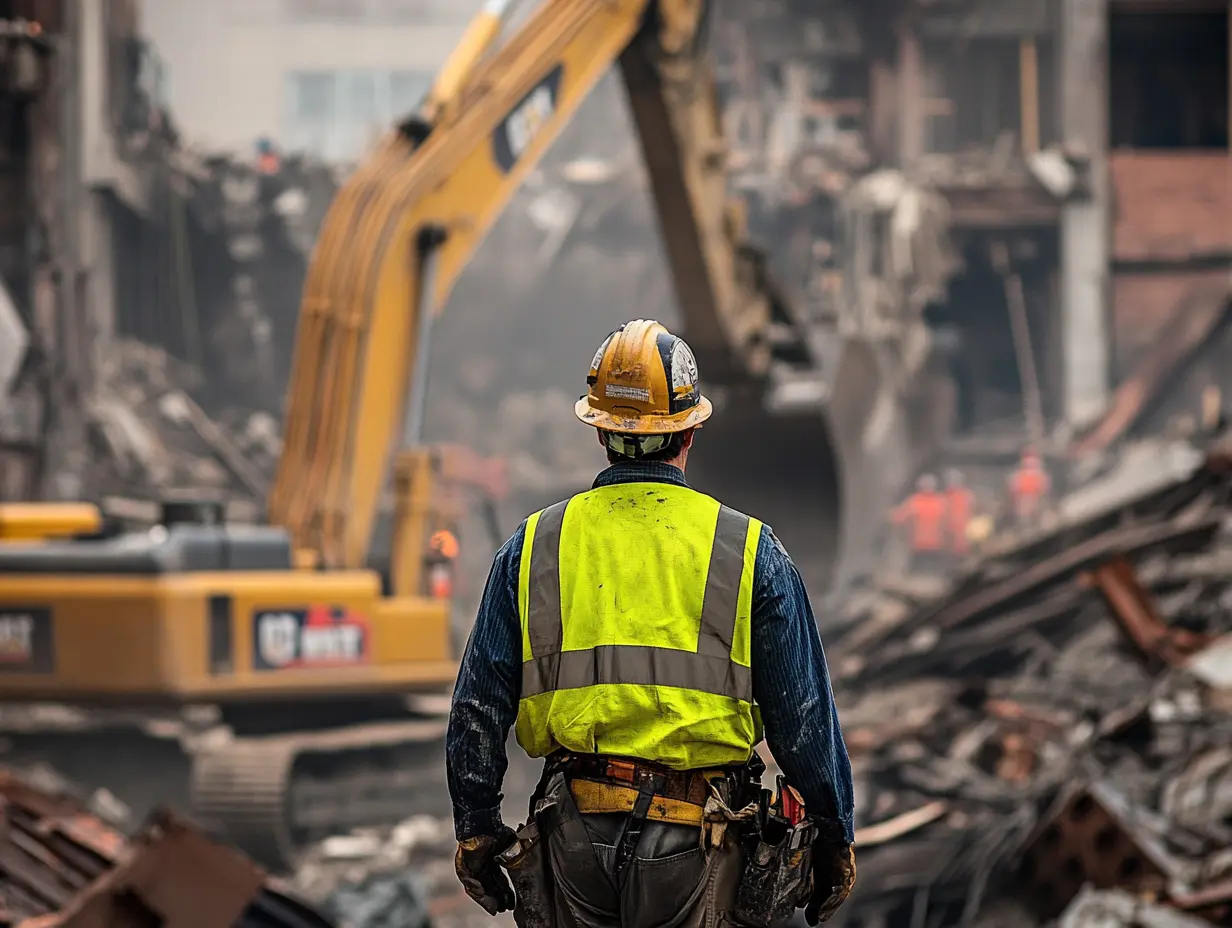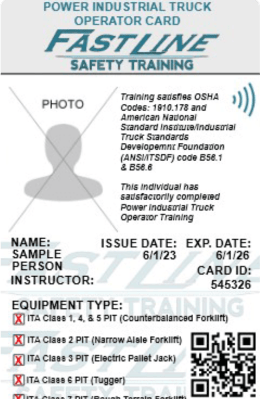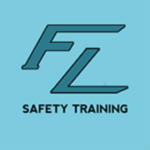
Course Duration
7.5 Hours
Course Session
1 Session
Language
English, Spanish
Training Type
Classroom Training
Course Overview
The aim of OSHA’s 7.5-hour Disaster Site Worker Course is a condensed version of the 15-hour course. It aims to provide disaster site workers with an understanding of the safety and health hazards they might face. This includes emphasizing the significance of respiratory and other personal protective equipment (PPE) and outlining decontamination procedures to mitigate potential hazards.
Participants will actively support the implementation of an Incident Command System (ICS) by safely executing their job responsibilities. They will also demonstrate awareness of the effects of traumatic incident stress resulting from working conditions and learn measures to alleviate this stress.
Fast Line Safety Training delivers high-quality, hands-on training at your location and provides the industry’s preferred operator card.
Additional Course Information
What you'll learn
- Identify and mitigate common hazards at disaster sites
- Proper use and maintenance of personal protective equipment (PPE)
- Basic first aid and CPR
- Effective communication and teamwork
- Disaster Site Safety protocols
- Basic principles of debris removal and site cleanup
- Awareness of mental health and stress management
CEU Credits Earned
0.75
Continuous Education Units
Who Should take this Disaster Site Worker Safety Course?
This 7.5-hour Disaster Site Worker Safety course is designed for a variety of individuals, including:
- Construction workers
- Emergency Responders
- Utility workers
- Volunteers
- Non-Profit organizations involved in disaster relief

Learning Outcomes
Upon successful completion of this course, participants will be able to:
- Recognize petential health and safety hazards present at disaster work sites
- Elaborate on decontamination procedures employed to minimize these hazards
- Promote the implementation of an incident Command System (ICS) by safely executing job
- Select and properly use appropriate personal protective equipment (PPE)
- Demonstrate effective communication and teamwork
Course Outline
Lesson 1: Introduction to Disaster Site Operations (1.5 Hours)
1.1 Characteristics of a Disaster Site:
- Types of disasters (natural, man-made, technological)
- Common hazards encountered (structural collapse, fire, flooding, hazardous materials)
- Environmental conditions (weather, terrain, accessibility)
- Psychological impact on victims and responders
1.2 Worker Responsibilities:
- Safety and situational awareness
- Following orders and procedures
- Communication and teamwork
- Victim care and assistance
- Self-care and stress management
Lesson 2: Safety Hazards and CBRNE Agents (1.5 Hours)
2.1 Common Safety Hazards:
- Electrical hazards
- Trip and fall hazards
- Confined space hazards
- Excavation hazards
- Fire and explosion hazards
2.2 CBRNE Agents:
- Overview of chemical, biological, radiological, nuclear, and explosive agents
- Recognition of potential threats and signs/symptoms of exposure
- Basic decontamination procedures for CBRNE agents
- Importance of protective measures
Lesson 3: Health Hazards and Traumatic Incidents Stress Awareness (1.5 Hours)
3.1 Common Health Hazards:
- Infectious diseases (bloodborne pathogens, respiratory infections)
- Musculoskeletal injuries (strains, sprains, back injuries)
- Heat stress and cold stress
- Exposure to hazardous materials
3.2 Traumatic Incident Stress Awareness:
- Understanding the psychological impact of disaster response
- Recognizing signs and symptoms of stress in oneself and others
- Stress management techniques (relaxation, breathing exercises, peer support)
- Available resources for mental health support
Lesson 4: Personal Pprotective Equipement (PPE) and Resporator Use (2.5 Hours)
4.1 PPE Selection and Use:
- Levels of PPE (levels A-D)
- Proper donning, doffing, and inspection of PPE
- Limitations of PPE
4.2 Respirator Use:
- Types of respirators (air-purifying respirators, supplied-air respirators)
- Fit testing and seal checks
- Limitations of respirators
- Proper use and maintenance of respirators
4.3 Hands-on Respirator Fit Testing and Use (if applicable)
Lesson 5: Decontamination (1.5 Hours)
5.1 Decontamination Principles:
- Purpose and importance of decontamination
- Types of decontamination (gross, technical)
- Decontamination methods (physical, chemical)
- Decontamination procedures for personnel and equipment
5.2 Decontamination Site Setup and Operations: (if applicable)
- Setting up a decontamination line
- Conducting a mass decontamination
- Managing contaminated materials
Lesson 6: Incident Command System (ICS) (1.5 Hours)
6.1 Introduction to ICS
- Principles of ICS(unity of command, span of control, modular organization)
- Key ICS positions (Incident Commander, Operations Section Chief, Planning Section Chief)
- Communication and coordination within the ICS structure
6.2 ICS Applications in Disaster Response
- Role of ICS in organizing and managing disaster response operations
- Communication and coordination with other agencies and organizations
Lesson 7: Final Exercise (1.0 Hours)
- A simulated disaster scenario (e.g., building collapse, hazardous materials spill)
- Application of learned skills and knowledge in a realistic setting
- Teamwork and communication within a simulated incident command structure
- Debriefing and discussion of the exercise
Pricing
Group
Minimum 5 person per class-
We Come to You
-
Schedule Flexibility
-
Hands-on Training
Inquire about setting up a private class for your team and ask about group discounts.
To successfully complete the training, students must:
- Earn a minimum score of 75% on the final evaluation.
- Complete 100% of the required course content.
- Completion of required pre-and post-quiz assessment
- Actively participate in all written and practical learning activities.
- Completion of Continuing Education and Training Registration Form
Please note that no make-up time will be provided for missed assignments or activities.
The Preferred Equipment Operator Card

QR Code/ NFC Technology
Digital ID Card: Quickly scan your card with any smartphone camera to experience the convenience of your digital identification profile.
Blockchain Protected
Blockchain-protected: Experience the next generation of security. Leveraging the power of blockchain technology, your cards are encrypted and tamper-proof, ensuring your information is always safe.
ID Cards with Face Photo
Full-resolution ID Cards: Fast Line Safety Training issues A standard identification card featuring a full-color photograph of the individual.
Completion cards are valid for 3 years and in all 50 states.
We are the only providers issuing such permanent cards.
Book your next training course with us.
Fill out the form below or call us at (631) 393 – 6755
to set up your training session!
l out the form below or
call us at (631) 393 – 6755
to set up your training session!

Frequently Asked Questions
What are the typical hazard encountered at disaster sites?
Disaster sites present numerous hazards, including structural collapse, electrical hazards, chemical spills, contaminated water, and exposure to hazardous materials. Workers may also face extreme weather conditions, physical exertion, and mental stress
Who is responsiblefor worker safety at disaster sites?
Both employers and employees share responsibility for worker safety at disaster sites. Employers must provide a safe work environment and adequate training, while employees are responsible for following safety protocols and using appropriate personal protective equipment (PPE).
What are the common causes of injuries at disaster sites
Common causes of injuries include falls, slips, trips, struck-by hazards, and exposure to hazardous materials. Improper use of PPE, inadequate training, and fatigue can also contribute to injuries.
How can this training help me stay safe at a disaster site?
This course will equip you with the knowledge and skills to recognize and avoid common hazards, use appropriate safety equipment, and work safely and effectively in challenging disaster environments



